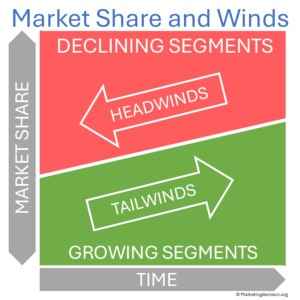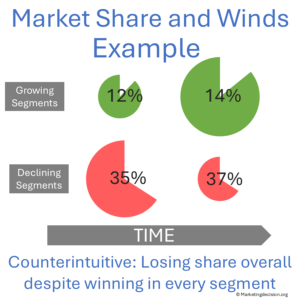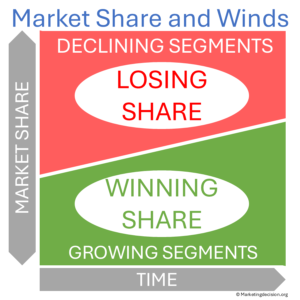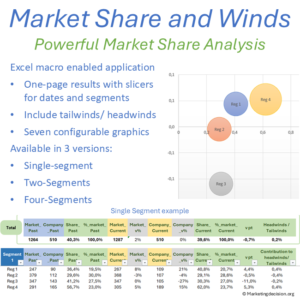A clear understanding of the market environment, trends, and growth drivers can provide invaluable insights into overall business activities and competitive dynamics. These insights play a crucial role in addressing key business questions, and their answers have significant implications:

These questions highlight why analyzing Market Share and Winds is essential for strategic decision-making.
This Market Share and Winds analysis helps reveal how external forces shape company growth.
Understanding the dynamics of market segments is essential for any business. A market typically comprises various segments, including customer groups, distribution channels, product categories, and geographic regions. Over time, these segments may undergo growth or decline, resulting in what is commonly referred to as market mix effects, often categorized as “tailwinds” and “headwinds.”
 A company positioned in growing segments benefits from tailwinds that can accelerate its growth when the company also gains market share within those segments. On the other hand, a company operating in declining segments faces headwinds, which hinder its overall ability to increase market share in the total market.
A company positioned in growing segments benefits from tailwinds that can accelerate its growth when the company also gains market share within those segments. On the other hand, a company operating in declining segments faces headwinds, which hinder its overall ability to increase market share in the total market.
It’s important to note:
This makes market share analysis not only about absolute numbers but also about the quality and growth trajectory of each segment.
Market share analysis should combine both internal performance and external growth factors.

Here is a practical example: Although Segment 1 and Segment 2 both improved their market share within their respective segments (12% → 14% and 35% → 37%), the company’s total market share dropped from 30% to 19%.
This paradox arises because the overall market structure shifted:
Segment 1 grew strongly (from 30 to 100).
Segment 2 declined (from 100 to 30).
Since the company was mainly positioned in Segment 2, which shrank sharply, total share fell despite local improvements. This illustrates the impact of headwinds and tailwinds — segment growth rates can outweigh share gains.
Therefore, companies should consider both:
Share gain or loss relative to competitors
Segment growth rates (tailwinds or headwinds)
 Comprehending market mix effects, including external factors known as tailwinds and headwinds, is particularly crucial.
Comprehending market mix effects, including external factors known as tailwinds and headwinds, is particularly crucial.
By mapping these drivers of growth or decline over time, companies can run trend analysis or even scenario analysis to anticipate different futures.
Measuring market mix effects offers several advantages:
It is more often heard of headwinds that slow growth and create barriers for companies, and less often of tailwinds. In fact, tailwinds are those events that companies must identify, such as faster-growing segments or favorable external drivers. The best companies adapt quickly by moving resources toward segments with sustained growth.
Similar to a boat race, the winner is the one that finds the winds that support the optimal course and carries the company forward.
Recommended reading:

Understanding the growth or decline of specific segments determines whether a company is well-prepared for the future. Investing in growing segments is essential to expand market share, sustain competitive advantage, and capture long-term growth.
Key questions for marketing and sales teams:
By leveraging your data and applying Market Share and Winds analysis, you can gain deeper insights into market trends, make better investment decisions, and build stronger business strategies.
Below are the most common questions about Market Share and Winds analysis, including its role in identifying tailwinds, headwinds, and market opportunities.
Tailwinds are external factors that boost growth in specific market segments, such as favorable regulations, rising demand, or technological innovation. Headwinds are the opposite — factors that slow growth in certain segments, including declining demand, supply shortages, or restrictive regulations.
A company can improve its share within individual segments but still lose overall share if those segments are shrinking while others in the market are expanding. This effect is known as a market mix effect.
Market winds help distinguish performance driven by internal actions from that caused by external forces. Recognizing them enables teams to focus investments on favorable segments and shape a stronger long-term growth strategy.
By combining internal sales data with external market estimates, calculating segment growth rates, and benchmarking against competitors. Tools like the Market Share and Winds framework make this process more structured and actionable.
It clarifies the true sources of performance, supports accurate sales evaluation, guides investment decisions, and helps identify long-term growth opportunities across market segments.
© marketingdecision.org
The Market Share and Winds tool is designed to help teams handle market data and quickly evaluate key insights across different market segments as soon as they become measurable. A central feature of this tool is its ability to identify headwinds and tailwinds—factors that can distort the perception of market share gains or losses. Incorporating additional tools that facilitate data collection and analysis can further enhance your understanding of market dynamics.
One challenge in market analysis is reconciling highly precise internal data with market estimates that may vary in quality. Ensuring the reliability of your data, clearly citing sources and collection methods, is a critical step in avoiding inaccurate conclusions. Transparent communication about the quality and origin of external data helps prevent misinterpretation and supports sound decision-making.
The following section may include tools, some free, some with a fee to support this site development. If you consider a tool should be presented in this section and is missing, please let us know at: contact@marketingdecision.org
 A clear understanding of the market environment and trends can provide invaluable insights into overall business activities and competitive dynamics. These insights play a crucial role in addressing key business questions with a significant impact for any company.
A clear understanding of the market environment and trends can provide invaluable insights into overall business activities and competitive dynamics. These insights play a crucial role in addressing key business questions with a significant impact for any company.
This Excel product with macros is specifically designed to facilitate ongoing market trend analysis and comparative assessments for a company in relation to your estimated market. It offers up to seven graphics for in-depth analysis and effective communication of key insights. This product is available in three versions.
Establishing team meetings to share and discuss the market environment is essential. As mentioned in this chapter on the Marketing Mix, there are multiple tools worth considering. Besides the Market Share and Winds approach that aims to provide quantitative data, check additional methods and tools to provide useful and practical information, such as the tool proposed below, to provide increased market visibility.
 Informed decision-making relies on a profound understanding of the market environment, current trends, company performance, and competitive strategies.
Informed decision-making relies on a profound understanding of the market environment, current trends, company performance, and competitive strategies.
The solution presented here is a team meeting checklist, a free tool designed to facilitate regular market review meetings. It serves to consolidate lessons learned, identify opportunities, and swiftly learn from mistakes. In essence, it helps identify actions to engage in order to leverage the situation to your advantage.
© 2025 MARKETING DECISION SOLUTIONS. All Rights Reserved.